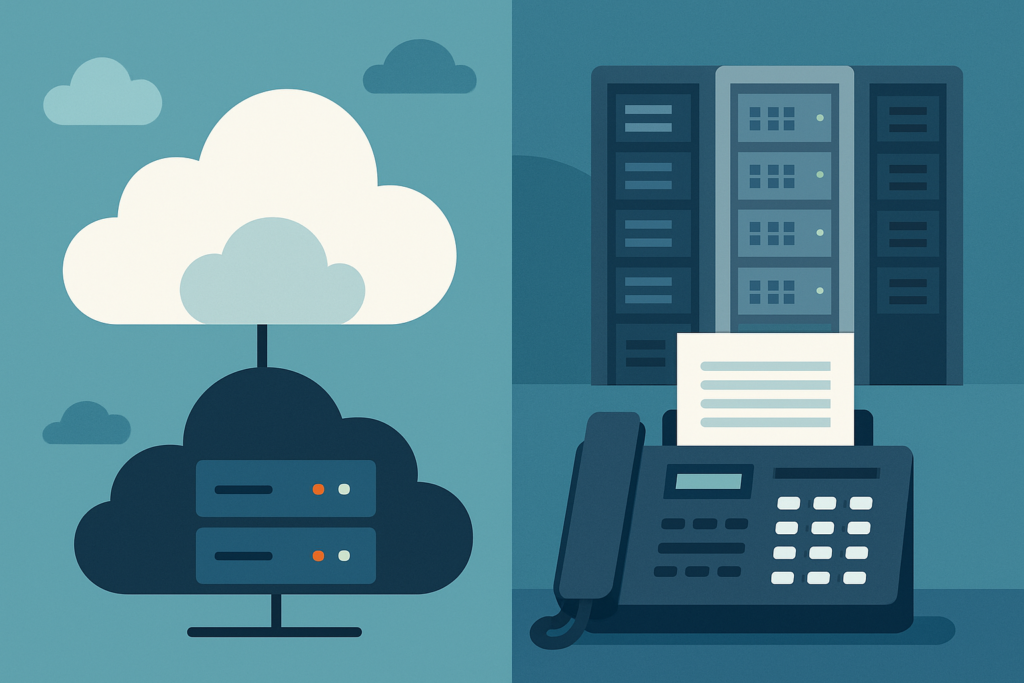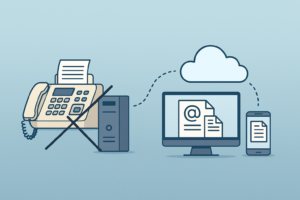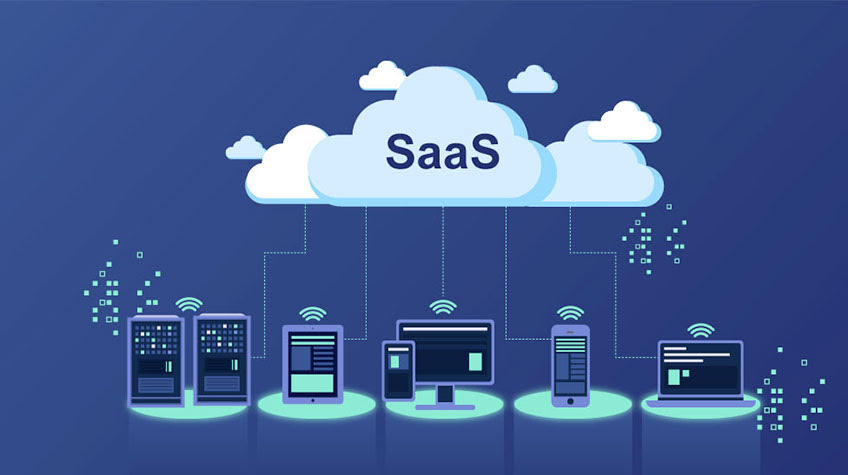How to choose implies you have choices to make. Let’s begin with the big picture choices.
Is a cloud-based service an option for all or some of the components in the solution? If not, then the fax server application must reside within your environment on Virtual Machines that run a Microsoft Windows Server operating system. There are no Linux or open-source fax server solutions worth considering if HIPAA and PCI compliance are a must.
The next requirement is the Telco part of the fax server solution. The big Telcom players (AT&T, Lumen, Verizon, etc.) have largely shut down their legacy copper telephone network which leaves you with no choice except SIP Trunks and Voice over IP services to choose from. In addition to the SIP Trunks you’ll need an IP Based phone system, such as Avaya, or a Session Border Controller (SBC). Then you need fax drivers (software) that actually place/answer the fax call using Fax over IP (FoIP) and T.38 or G.711 are the two ways to implement FoIP.
If your entire Enterprise fax server solution is residing in a datacenter then Telco offerings are more limited than using an on-premise IP-PBX, making this another essential component that needs to be explored for what is possible. Getting a SIP Trunk and a SBC setup and configured in a datacenter is difficult and costly.
Many organizations who need to host their Enterprise fax server application in a third-party datacenter have gone with a hybrid, or ‘Partly Cloudy’ implementation where the fax modem and Telco connections are in the cloud is the best alternative. FaxCore pioneered this unique combination of an on-premise fax server while the fax numbers, phone lines and fax modems are in the cloud. This Partly Cloudy approach is both HIPAA and PCI compliant as the fax images are not stored in the cloud, only on the FaxCore fax server under your control.
Should You Choose a Cloud-Based Fax Service or an On-Premise Fax Server?
To cloud or not to cloud is more than just addressing concerns about data security and regulatory compliance.
- Are features which are taken for granted with on-premise fax servers available with a fax service in the cloud
- When the fax service is in the cloud, how do the received faxes get into your on-premise healthcare applications, securely?
- Can email be used to send and receive faxes?
- Are APIs available so documents can be transferred between applications, securely?
- What datacenters are used by the cloud fax service and are they in the US?
- What about SSO and integration with Microsoft’s Active Directory?
- What other forms of Identity Access Management are supported?
- How long are the faxes retained by the fax service in the cloud?
- I need the fax delivered to a server on my network, immediately and securely. How is that done?
FaxCore’s fax service uses the same software that is installed by customers within their network, so all features and functionality are available. FaxCore has answers and recommendations for all of the questions you will have.
Sending faxes from what to where, how and when?
The next ‘big picture’ consideration is how the faxes are created and from what applications. Many EMR/EHR applications have APIs that are used to integrate with fax servers so there is no user involvement with the actual fax server application to send or receive a fax. Other processes usually include the fax being created from within an application and then using a fax printer, like FaxCore’s IP Fax Printer to create a fax job and send it.
All fax server applications offer a user interface, some more user friendly than others, as a way to send faxes, monitor the status of faxes sent and to access received faxes. Enterprise class fax servers offer options to assemble different documents from different applications into a single fax transmission, which is a unique feature yet a common requirement.
Faxes can also be created and submitted with a status of ‘Hold’ so they can be reviewed by the sender or a manager, before being released and sent. Fax jobs can also be scheduled for a later delivery date or time. This feature could be used to send faxes at night when the recipient’s fax lines won’t be busy.
Essential Enterprise Fax Features: Page Splitting, Job Scheduling, and Workflow Integration
Imagine getting a fax that contains 800 pages, or even more, and then the information contained within that fax needs to get into the appropriate application. One important feature to facilitate ‘workflow’ processes is splitting fax pages into separate documents that organize the appropriate pages for delivery into another healthcare application.
Working with the fax in the fax server application is a must and advanced features such as page splitting, adding tracking data, forwarding the fax to another user or fax number and saving the fax into specific folders are must haves. Additionally, for HIPAA compliance an audit trail that records all activities related to that fax message is a requirement.
There are numerous companies providing automated processing of the faxes to reduce data entry, data entry mistakes, facilitating workflow processes and archiving of the faxes. Find out what integration options are available for your EMR/EHR application and consult with your fax service provider about additional possibilities and integrations already in place that are being used successfully.
Secure Document Transfer: Moving Faxes from the Cloud to Your On-Premise Servers
Moving documents around are easy with the Internet and a variety of options such email, DropBox, and other file sharing services are available. But not all meet HIPAA and PCI security guidelines and they all require a person manually creating the transfer. OK for an occasional document but what about hundreds or thousands of faxes coming in every day and they need to get from the cloud to the ground (your servers) securely, through firewalls and with user account credentials? Microsoft has some great utilities available that will synchronize folders in their Azure datacenter with folders on servers in your network, securely. FaxCore has been deploying these technologies for years with 100% uptime and 100% reliability.
The paperless office will occur around the same time we have the paperless bathroom!
Faxes used to be entirely associated with paper stuffed into a fax machine or picked up from the fax machine. Fax servers, which eliminate the paper aspect of faxing have been around for over 40 years yet paper is still part of some processes. Over the past few decades, manufacturers of fax machines, copiers and scanners have combined all of those functions in a single device, referred to as a Multi-Function Printer (MFP) or Multi-Function Device (MFD). Some of the more advanced MFPs from Sharp, HP, Konica Minolta, Xerox and others have an API/SDK that can be leveraged by fax server applications to present the desktop fax experience at the MFP panel. User login requirements, access to Address Books, fax confirmations of sent faxes, selecting a received fax to print at the MFP are all functions that can be done from the MFP connecting to the fax server.
Most MFPs also support the sending of paper documents to a fax server that’s on-premise, or in the cloud. It is typically referred to as ‘Internet Fax’, ‘Fax Server’ or some other similar term. The transport is actually email using SMTP settings. The sender of the document puts the paper in, hits the Fax button, enters the fax number and the Green go button. The document is scanned and then emailed to the fax number preceding the domain name of the fax server or fax service domain name. The tricky part for HIPAA compliance is making sure the email leaving the MFP is going over a secure TLS connection to the fax service. Office 365 customers could setup a secure (TLS) connections between their Office 365 instance and the 3rd party fax service if it also supports TLS.
The benefits of integrating MFPs into a fax service/server are numerous:
- No phone lines to connect to a fax device.
- No ‘Fax Kits’ in the MFP than can cost $1,000
- Compliance with HIPAA is achieved since the fax service/server has the audit trail of what was sent to who, when and how.
- With an advanced integration that uses an MFPs API or PaperCut, the transmission also includes the person/user who sent the fax.
- No need to keep a fax machine around for the occasional paper fax job.
- If the fax fails, it can easily be resent from the fax service/server user interface, eliminating the need to take the paper back to the MFP.
The bottom line.
The majority of organizations want to get away from on-premise software and move it to the cloud. Some fax server companies have had an easier path to making the transition to the cloud painless yet comfortable from a user experience and security audit.
The path to the cloud and complying with Federal regulatory requirements is getting easier as the providers of these services have enhanced their offerings.
Look for a fax service or on-prem fax server solution that has support based in North America. Great support from someone who’s first language is more important than most people realize. Look for a provider that hosts all of their operations in the US and in datacenters from Microsoft (Azure), it will enhance your management of users, IAM and SSO. Lastly, do not enter into long term contracts. Fax usage varies from month-to-month and year-to-year. Don’t lock into a fixed expenditure if you think your faxing volume may decline.




